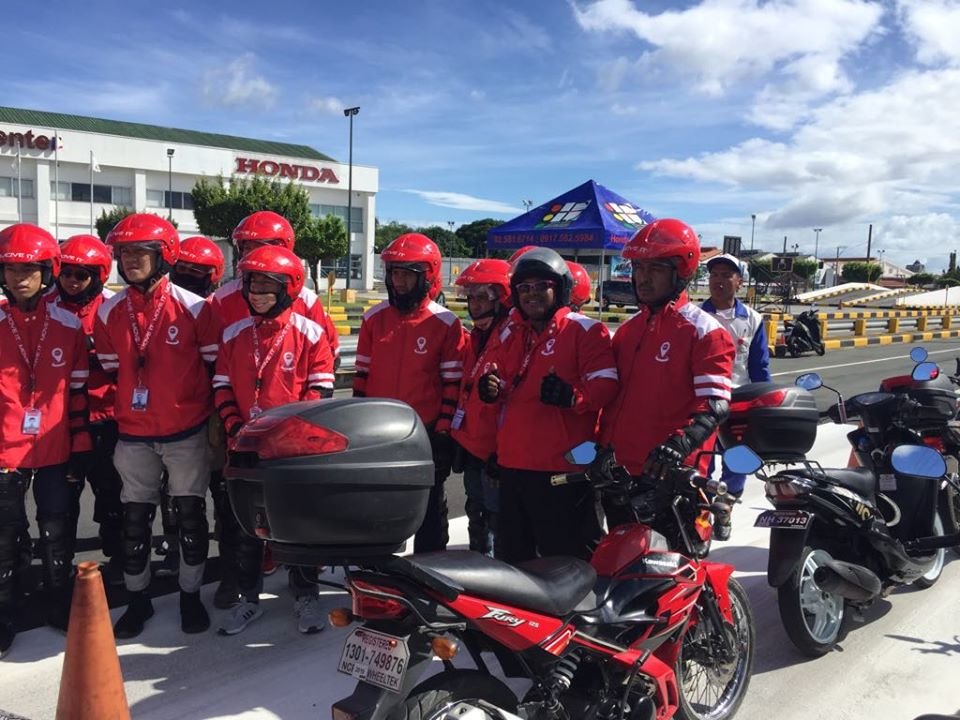
READY TO DRIVE Members of MoveIt, a motorcycle taxi-service provider that will join pioneer Angkas in a three-month pilot test extension, look forward to competing against the pioneer bike-hailing group. —CONTRIBUTED PHOTO
MoveIt, one of the two motorcycle taxi-service providers that regulators chose last week to join pioneer Angkas in a three-month pilot test extension, is touting certain features of its service to differentiate itself from competitors.
While bike-hailing is a fairly straightforward process, MoveIt has installed extra features to guarantee the safety of and continuous feedback from its drivers and passengers, said Eric Torres, operations manager of the ride-hailing platform.
For one, passengers can share their live location with friends and family who can track them while they’re on the ride, Torres said.
MoveIt has also added a feedback mechanism in which drivers and passengers can rate each other.
“That way,” Torres said, “we know how we perform, and we have a record also of how the customer was.”
All the raw data will be fed directly to the multiagency Technical Working Group (TWG) during the three-month pilot test, which will run until March 23.
“That’s the difference between the first and the extended pilot test,” Torres said.
Big demand
The three-month test run is aimed at determining whether motorbikes are safe for public transport. There is big demand for motorcycle taxi service in Metro Manila where commuters often spend three to fours hours daily on the road while taking traditional public transport to get to work and home due to severe road congestion.
As the names of its two competitors appear on the news, MoveIt busies itself with the prospect of entering a market long accustomed to and remarkably protective of Angkas, the country’s first motorcycle taxi service. The other newbie is JoyRide.
“Of course, we need to make ourselves known to the riding public,” Torres said in an interview with the Inquirer. “The challenge like any other, is getting the right number of riders to run your fleet and then getting a good share of the customer base to take on your services.”
Parcel delivery
Right now, around 1,414 drivers have joined MoveIt’s platform, which began initially as a parcel delivery service.
Operating a fleet of motorcycle taxis has been among MoveIt’s goals since Trans-Serve Corp., its parent company, began in 2015, Torres said. But the firm had to shelve the service as bikes-for-hire are still banned under Philippine laws.
So when the Department of Transportation announced the first pilot run in May, Torres said, MoveIt had expressed its intent to join. “But the department expressed preference for one player for easier monitoring. We just respected that and we just focused on enhancing the app and preparing for parcel delivery.”
Equalizer
Torres was confident that MoveIt, despite being a startup, could keep pace with its two other competitors, one of which has been in the running since 2017. The equalizer is the TWG guidelines, which provide a strict set of rules that the companies must follow.
Of the guidelines, perhaps the most important requirement is to make sure that the drivers undergo a rigorous training process that not only assesses their navigation skills but also their ability to transport a “backrider” (passenger).
For this, MoveIt has tapped Honda Safety Training Center, perhaps the only certified motorcycle training center in the country. There, drivers are taught the basics of road and traffic conditions, and undergo a separate vehicle inspection to test their bike’s safety and integrity.
Applicant drivers can avail themselves of this training for free and for as many times as they need, said Torres. But it’s a careful process. “Not all who apply are accepted. So you see, even if the process itself is simple, we’re very careful especially when both the government and the public are watching.”
Apart from the training, MoveIt’s riders are also given safety gear and service merchandise for which they must pay a “performance bond.” This bond acts like a deposit, which is refundable once they permanently leave the platform.
Real-time monitoring
“Under the new amended guidelines, the TWG will be given access to our database and dashboard,” Torres said. “They can now monitor our real-time operations.”
The amended guideline is crucial if the TWG wishes to wrap up the test by March. During the first leg of the study, the group had to wait for
Angkas’ monthly data before it could validate and assess the results.
That, in part, caused the current confusion between
Angkas and transport regulators, who are disputing the number of riders on the platform of the motorcycle taxi-service provider. Angkas claims to have 27,000 drivers, but the TWG only has over 2,400 drivers on hand.
Drivers welcomeWill MoveIt be willing to accommodate some of the 17,000 Angkas drivers who will fall outside the 10,000 cap set by the TWG?
“Of course,” Torres said. “We will try to fill up our slots as much as possible. We welcome all, even ‘habal-habal.’ But they’ll still have to go through the process to be fair to all applicants.”
MoveIt would ensure that its rates are competitive to entice more riders on its platform, according to Torres. Riders, for one, can benefit from an 80-20 sharing scheme in their favor and from state-mandated insurance.
Ultimately, MoveIt is looking to help make the three-month study successful. And the sooner the study is terminated, “the better for everyone involved,” Torres said.
“If you just keep on extending the study, it could mean we’re not getting anything from the study,” he said. “The aim really should be to have meaningful data and analysis to send to Congress so that it can craft a law at the soonest possible time. The sooner they’re able to enact the law, [the] better not just for the motorcycle [drivers] but for the already troubled commuting public as well.”